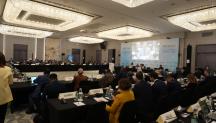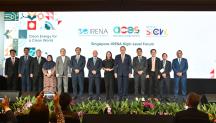About
SolarCity
SolarCity simulator is a web application built to assist homes, businesses, and municipal authorities in evaluating the prospects for electricity generation using rooftop-mounted solar photovoltaic (PV) systems.
For homes and businesses, the simulator provides a means to calculate potential savings compared to alternative power sources and alternative financing models.
For municipal authorities, the simulator enables the assessment of the prospective effect of policy incentives, such as generation subsidies or capital subsidy, in creating solar PV rooftop markets in their city. Metrics include the cost of incentive, the total volume of investment created, and the environment and climate adaptation benefits.
SolarCity simulator combines ultra-high-resolution three-dimensional building footprints with solar irradiation data, computed at 50-centimeter (cm) grid cells. It is one of a series of web-applications developed as part of IRENA’s Global Atlas for Renewable Energy initiative.
FAQ
What is SolarCity?
SolarCity is a web-application provided by IRENA that enables homes, businesses, and municipal authorities to evaluate the prospects for electricity generation using rooftop-mounted solar PV installations.
Is SolarCity a global solution?
The methodology at the core of SolarCity simulator can be deployed worldwide, in locations where the solar potential is high but not yet prospected. The first implementation of the simulator was for the district of Kasese in Uganda. The next application – currently in development – will cover the district of Chongli, Zhangjiakou, China. IRENA hosts the outcomes as components of the Global Atlas.
To what extent is shading on rooftops considered in the solar irradiation models?
The solar irradiation model for SolarCity is very accurate. To correctly estimate the effects of shading, rooftops are captured in three dimensions, with the respective tilt and azimuths of each rooftop section determined before the shading simulations.
See methodology.
What is the spatial resolution of the solar irradiation and PV module production calculations?
The calculations have been done with a base resolution of 50 cm, the same as the source imagery.
Which solar module was used to estimate the production potential on each rooftop, and is there an option to compare different panels?
IRENA, together with its research partner Khalifa University, modelled three groups of readily available modules to compare their performance on three locations in Kasese. The conventional polycrystalline silicon modules used in this analysis were found to provide the lowest levelised solar module cost of approximately USD 0.10 kWh in Kasese with the monocrystalline modules increasing the cost by 9 % and the high-efficiency modules by 23 %. Although the high-efficiency modules unsurprisingly turned out to provide the best technical performance, this gain in yield was found not to compensate for their higher price-per-watt levels. A similar exercise will be conducted in Zhangjiakou and future cities.
What is the uncertainty in the solar PV Performance calculations?
The combined uncertainty in the models used in performing these calculations (irradiation and performance) is estimated to be typically around 5% when fed with accurate input. However, as this is the first implementation, with rooftop attributes that have been calculated from satellite-sourced imagery at 50 cm, the precise uncertainty estimate will be updated after the publishing of the platform.
Can I obtain seasonal generation profiles from the tool?
No. The PV performance modelled in the SolarCity simulator, although calculated on an hourly time stamp over a typical meteorological year, has been aggregated to provide annual average results to simplify the calculations and visuals.
Is storage accounted for in this model of the software?
For this version, the option to configure storage has not been added. It should be added to future iterations of the application.
Is net metering accounted for in this model of the software?
The general architecture for the SolarCity simulator contains a module for empirical and business assessments of net metering and incentivised self-consumption policies.
What is the source of the default investment and operating costs?
For investment and operating costs, the default values are obtained from either
IRENA’s Costing Database or the local project developers in the city. The users can edit these values.
How can I request a simulator for my city?
The current version of the SolarCity simulator has been built for demonstration in Kasese, Uganda. A second version is planned for a demonstration in Zhangjiakou, China. With careful consideration on a case by case basis, IRENA may work with governments in more countries to develop versions of the simulator for selected cities in their countries. Please contact IRENA for more information at
GlobalAtlasServices@irena.org.
Can IRENA perform a detailed analysis of a city?
On a case by case basis, IRENA may decide to use the capabilities of SolarCity to conduct specific studies required by its Members. The outcome for such studies could be in the form of a published report and may not include interactive software online. Please contact IRENA for more information at
GlobalAtlasServices@irena.org.
Does IRENA host SolarCity?
The SolarCity, while operated by IRENA, is a cloud-hosted service. This hosting choice has been made to enable the most cost-effective operating environment for the software.
Where can we find more details on the methodology used in SolarCity?
Please download a report on the methodology,
here






